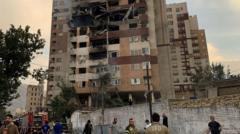The strategic objectives of Israel's strikes against Iran's nuclear infrastructure come amidst heightened tensions in the Middle East, particularly surrounding Iran's advancements in its nuclear program. Israel's military has focused on several key locations, including the Natanz facility, which has long been suspected of harboring advanced uranium enrichment capabilities.
# Israeli Airstrikes Target Key Iranian Nuclear Sites: Implications and Reactions

# Israeli Airstrikes Target Key Iranian Nuclear Sites: Implications and Reactions
In a significant escalation of hostilities, Israeli airstrikes have targeted critical nuclear sites in Iran, raising concerns over regional stability and nuclear proliferation.
Despite strong military action, the broader geopolitical consequences remain uncertain.
Israel's military actions carry profound implications, not only affecting Iran's nuclear ambitions but also potentially complicating its relations with other global powers. The airstrikes are seen as a preemptive measure to thwart what Israel perceives as an existential threat, given Iran’s advancements in uranium enrichment capabilities that could facilitate nuclear weapons development.
### The Targeted Facilities
A closer examination of the targeted facilities reveals their significance:
1. **Natanz**: Approximately 140 miles south of Tehran, this facility is Iran's main uranium enrichment center, housing thousands of centrifuges. Despite past attacks, which include the notorious Stuxnet cyberattack, Iran has continually repaired and upgraded Natanz. The recent Israeli airstrike appears to have inflicted severe damage, though the International Atomic Energy Agency (IAEA) has confirmed no radiation leaks have been detected so far.
2. **Fordow**: This facility, buried deep underground near Qom, is Iran's most fortified site, making it particularly challenging to target effectively. The facility is vital for advancing Iran's uranium enrichment to near weapon-grade levels.
3. **Parchin**: This military complex has been a subject of international scrutiny and is associated with Iranian tested high explosives that could be used in nuclear warheads. Access to Parchin has been denied to IAEA inspectors, raising further concerns about verification of Iran’s nuclear activities.
4. **Bushehr**: As Iran's sole operational nuclear power plant, located along the Persian Gulf, it represents a crucial part of Iran's civilian nuclear energy strategy, utilizing Russian fuel.
### International Reactions
The military actions prompted strong condemnation from international leaders, including Rafael Grossi, head of the IAEA, who expressed deep concern about the implications of military operations on nuclear safety. Grossi highlighted the potential consequences for both Iran and the broader region, asserting that military actions jeopardizing nuclear facilities pose serious risks to global peace and security.
Israel's airstrikes also raise the question of retaliation from Iran, which has vowed to respond to any military aggression. The potential for escalating military engagements could destabilize the region, with implications for countries neighboring Iran, as well as international powers involved in nuclear diplomacy.
### Conclusion
As the international community grapples with the fallout from these military operations, the focus will remain on whether the strikes achieve their intended outcomes or merely escalate tensions further. The situation continues to evolve, underscoring the intricate balance of regional power politics and the delicate nature of nuclear proliferation dynamics.
The stakes are high, and the coming weeks may reveal the long-term consequences of these recent actions in the Middle East.
---
This article provides an analysis of the ongoing conflict surrounding Iran's nuclear ambitions and the implications of military actions taken by Israel in response. It aims to present a comprehensive view of the situation from multiple perspectives, emphasizing the intricacies of international relations and security concerns.
Israel's military actions carry profound implications, not only affecting Iran's nuclear ambitions but also potentially complicating its relations with other global powers. The airstrikes are seen as a preemptive measure to thwart what Israel perceives as an existential threat, given Iran’s advancements in uranium enrichment capabilities that could facilitate nuclear weapons development.
### The Targeted Facilities
A closer examination of the targeted facilities reveals their significance:
1. **Natanz**: Approximately 140 miles south of Tehran, this facility is Iran's main uranium enrichment center, housing thousands of centrifuges. Despite past attacks, which include the notorious Stuxnet cyberattack, Iran has continually repaired and upgraded Natanz. The recent Israeli airstrike appears to have inflicted severe damage, though the International Atomic Energy Agency (IAEA) has confirmed no radiation leaks have been detected so far.
2. **Fordow**: This facility, buried deep underground near Qom, is Iran's most fortified site, making it particularly challenging to target effectively. The facility is vital for advancing Iran's uranium enrichment to near weapon-grade levels.
3. **Parchin**: This military complex has been a subject of international scrutiny and is associated with Iranian tested high explosives that could be used in nuclear warheads. Access to Parchin has been denied to IAEA inspectors, raising further concerns about verification of Iran’s nuclear activities.
4. **Bushehr**: As Iran's sole operational nuclear power plant, located along the Persian Gulf, it represents a crucial part of Iran's civilian nuclear energy strategy, utilizing Russian fuel.
### International Reactions
The military actions prompted strong condemnation from international leaders, including Rafael Grossi, head of the IAEA, who expressed deep concern about the implications of military operations on nuclear safety. Grossi highlighted the potential consequences for both Iran and the broader region, asserting that military actions jeopardizing nuclear facilities pose serious risks to global peace and security.
Israel's airstrikes also raise the question of retaliation from Iran, which has vowed to respond to any military aggression. The potential for escalating military engagements could destabilize the region, with implications for countries neighboring Iran, as well as international powers involved in nuclear diplomacy.
### Conclusion
As the international community grapples with the fallout from these military operations, the focus will remain on whether the strikes achieve their intended outcomes or merely escalate tensions further. The situation continues to evolve, underscoring the intricate balance of regional power politics and the delicate nature of nuclear proliferation dynamics.
The stakes are high, and the coming weeks may reveal the long-term consequences of these recent actions in the Middle East.
---
This article provides an analysis of the ongoing conflict surrounding Iran's nuclear ambitions and the implications of military actions taken by Israel in response. It aims to present a comprehensive view of the situation from multiple perspectives, emphasizing the intricacies of international relations and security concerns.


















